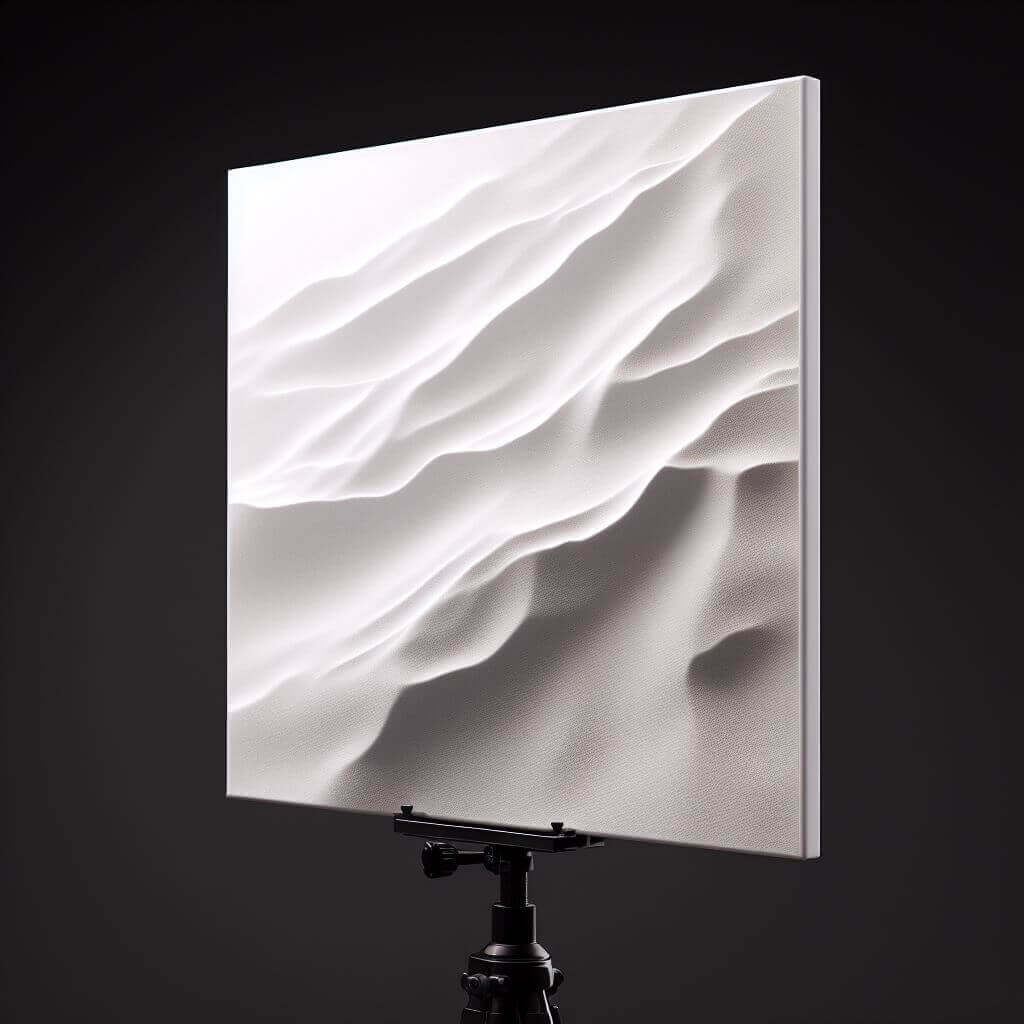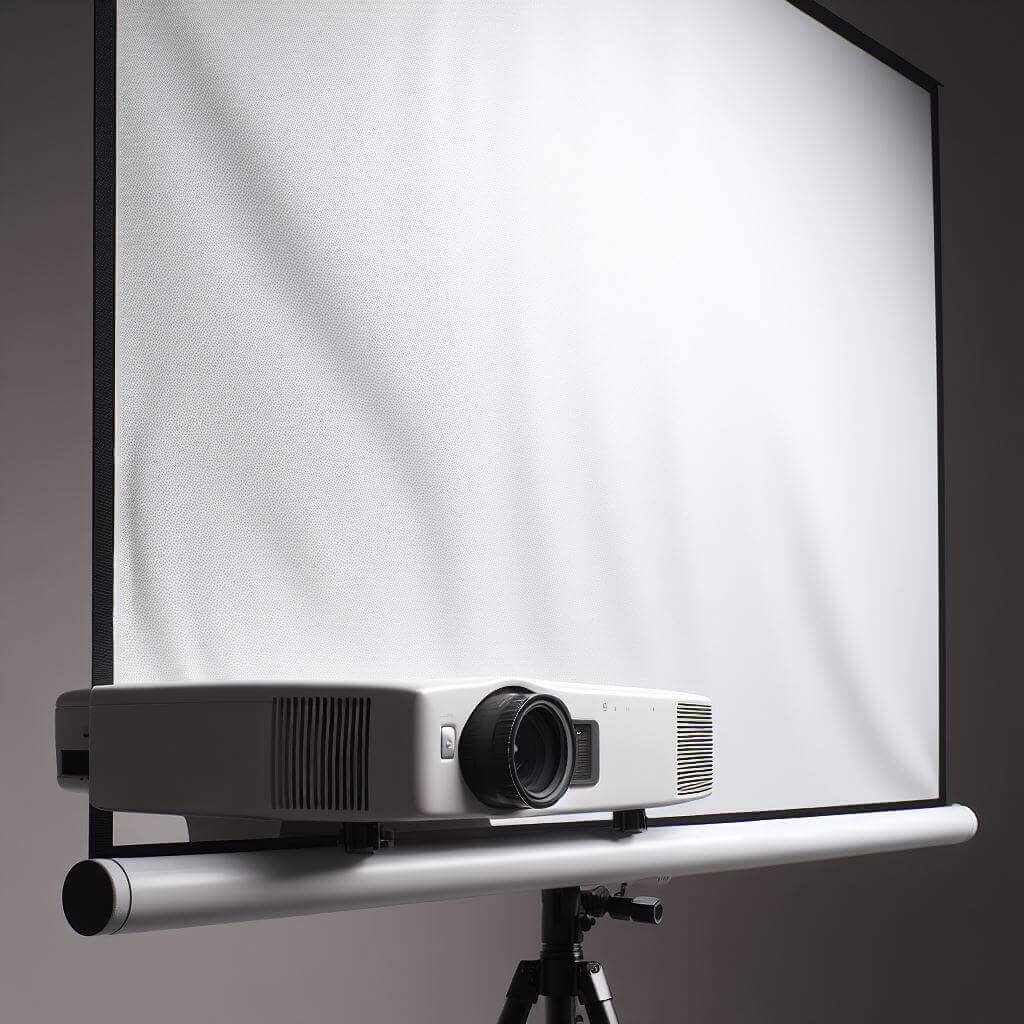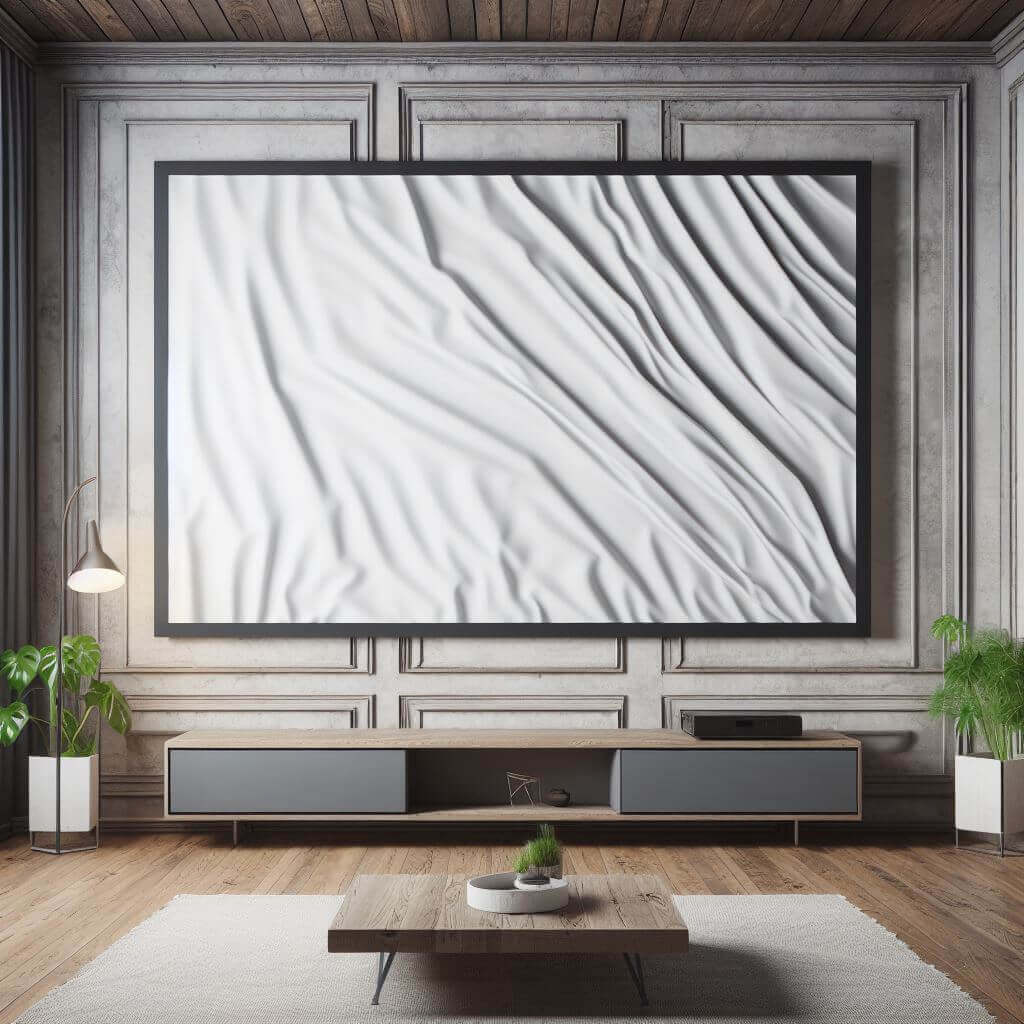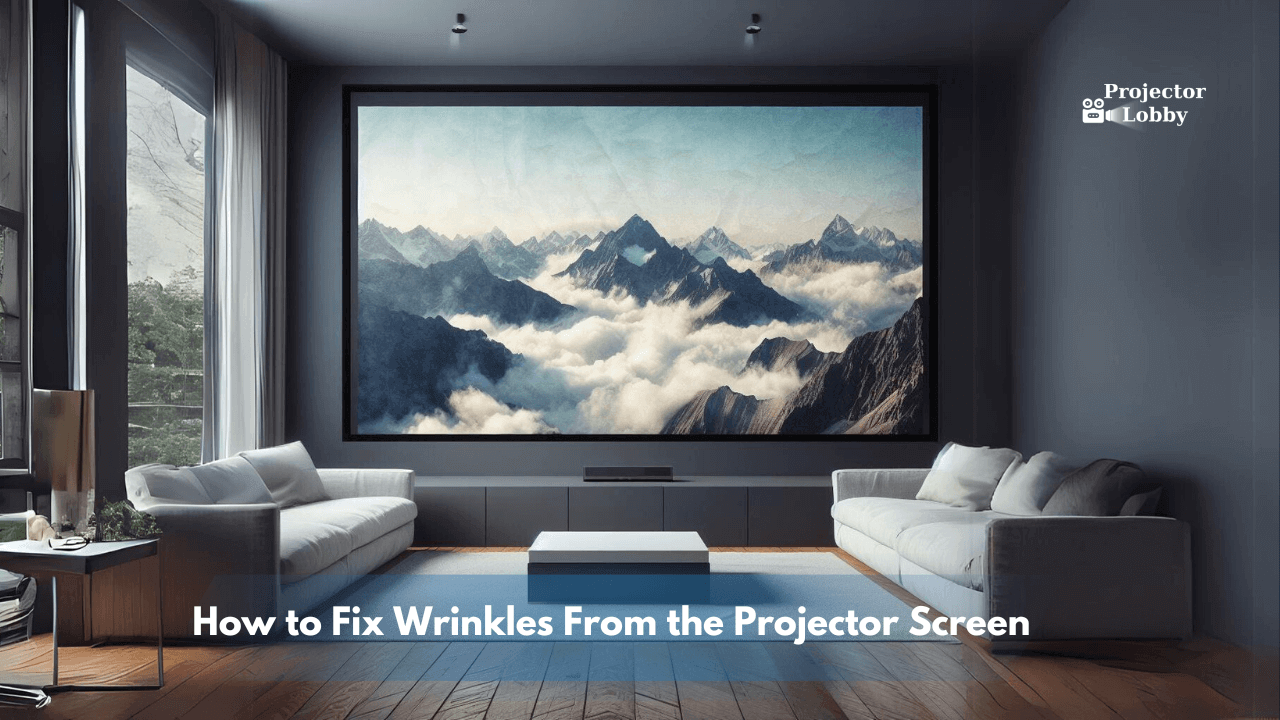Projector screen wrinkles can significantly impact the viewing experience, causing distortion and reduced image clarity. In this guide, we will explore the common causes of wrinkles and provide a detailed, step-by-step approach to fixing them. Whether you have a fabric, vinyl (or PVC), or aluminum projector screen, understanding the causes and solutions for wrinkles is essential for maintaining an optimal viewing environment.
Wrinkles in projector screens can result from improper storage, transportation, or installation. These wrinkles not only affect the aesthetics of the screen but can also cause distortion in the projected image. It is crucial to address these wrinkles to ensure a smooth, clear, and enjoyable viewing experience.
In the following sections, we will discuss the causes of wrinkles, provide specific instructions for fixing wrinkles in different types of projector screens, and offer preventative measures to maintain a wrinkle-free surface. Let’s explore how to effectively address projector screen wrinkles and restore the quality of your viewing experience.
Understanding the Causes of Wrinkles
Projector screen wrinkles can occur due to a variety of reasons, including improper storage, transportation, and installation. When projector screens are folded or creased during storage or transportation, it can lead to the formation of wrinkles. Similarly, incorrect installation techniques, such as applying uneven tension or using excessive force, can also result in wrinkles on the screen surface.
The impact of wrinkles on image quality and clarity is significant. When a projector screen has wrinkles, it can cause distortion and uneven light reflection, resulting in a compromised viewing experience. The wrinkles may also cast shadows or create blurry areas on the projected image, detracting from the overall clarity and sharpness.
Understanding these common causes and their effects is crucial in addressing projector screen wrinkles effectively. By identifying the root causes, it becomes possible to take targeted steps to remedy the issue and restore the smooth, wrinkle-free surface necessary for optimal projection quality.
Preparing for the Fix
Before diving into the process of fixing projector screen wrinkles, it’s essential to prepare adequately. Here are the key steps to take in preparation for addressing the issue:
Gather the Necessary Tools and Materials
To effectively address wrinkles in your projector screen, you will need specific tools and materials. These may include a handheld steamer for fabric screens, a hair dryer or heat gun for vinyl screens, or tensioning systems for aluminum screens. Additionally, you may require a soft cloth or sponge for cleaning, as well as any specialized products recommended for your specific screen material.
Assess the Severity of the Wrinkles
Examine the projector screen closely to assess the severity of the wrinkles. Identify any areas where the wrinkles are particularly pronounced or where multiple creases have formed. This assessment will help you determine the most effective approach for addressing the wrinkles and ensure that you allocate the necessary time and resources to achieve a smooth, wrinkle-free surface.
Identify the Type of Projector Screen Material
Different types of projector screens, such as fabric, vinyl, or aluminum, require specific approaches for addressing wrinkles. By identifying the material of your projector screen, you can tailor your approach to best suit its characteristics and ensure that the fix is both effective and safe for the material involved.
Taking these preparatory steps will set the stage for a successful resolution to the issue of projector screen wrinkles. With the necessary tools, a clear understanding of the severity of the wrinkles, and knowledge of the screen material, you’ll be well-equipped to proceed with confidence in addressing the problem.
Fixing Wrinkles in Fabric Screens

When dealing with wrinkles in fabric projector screens, using a handheld steamer can be an effective approach to remove wrinkles and restore a smooth surface. Here are step-by-step instructions for using a handheld steamer:
- Prepare the Steamer: Fill the handheld steamer with water and allow it to heat up according to the manufacturer’s instructions. Ensure that the steam is not too hot, as excessive heat can damage the fabric.
- Test on a Small Area: Before applying the steamer to the entire screen, test it on a small, inconspicuous area to ensure that the fabric can withstand the heat and moisture without adverse effects.
- Hold the Steamer at a Distance: Hold the handheld steamer at a distance from the fabric screen, allowing the steam to penetrate the wrinkles without direct contact with the material. Move the steamer back and forth across the wrinkled areas, gently applying the steam to release and relax the fabric.
- Smooth Out the Fabric: As the steam penetrates the fabric, use a soft cloth or sponge to gently smooth out the wrinkles. Avoid applying excessive pressure, as this can stretch or damage the fabric.
- Allow Time to Dry: Once the wrinkles have been smoothed out, allow the fabric screen to dry thoroughly before retracting or repositioning it for use. This will help ensure that the fabric maintains its smooth, wrinkle-free appearance.
Tips for Avoiding Overexposure to Heat and Potential Damage to the Fabric
- Always follow the manufacturer’s guidelines for using a handheld steamer on your specific fabric screen material.
- Avoid prolonged exposure to heat, as excessive moisture and high temperatures can damage certain types of fabric.
- Use gentle, sweeping motions when applying the steam and smoothing out wrinkles to minimize the risk of stretching or distorting the fabric.
By following these step-by-step instructions and adhering to these tips, you can effectively remove wrinkles from fabric projector screens while minimizing the risk of overexposure to heat and potential damage to the fabric.
Fixing Wrinkles in Vinyl Screens (PVC Screens)

When addressing wrinkles in PVC or vinyl projector screens, using a hair dryer or heat gun can be an effective method for removing wrinkles and restoring a smooth surface. Here’s an explanation of how to use these tools and the necessary safety precautions and temperature recommendations for vinyl material:
Using a Hair dryer or Heat Gun to Remove Wrinkles
- Prepare the Hair dryer or Heat Gun: Set the hair dryer or heat gun to a low or medium heat setting to avoid overheating the vinyl material. Ensure that the tool is held at a safe distance from the screen to prevent damage.
Apply Heat to the Wrinkled Areas: Direct the airflow from the hair dryer or the heat gun evenly across the wrinkled areas of the vinyl screen. Use a sweeping motion to distribute the heat and gradually relax the material. - Smooth Out the Vinyl: As the vinyl becomes more pliable from the heat, gently smooth out the wrinkles using a soft cloth or sponge. Be cautious not to apply excessive pressure, as vinyl can be sensitive to stretching or distortion.
- Allow Time to Cool: Once the wrinkles have been smoothed out, allow the vinyl screen to cool down and set in its new, wrinkle-free state before handling or adjusting it.
Safety Precautions and Temperature Recommendations for Vinyl Material
- Always maintain a safe distance between the hair dryer or heat gun and the vinyl screen to prevent overheating and potential damage.
- Avoid using high heat settings, as excessive temperatures can cause the vinyl material to warp or become discolored.
- Test the heat tool on a small, inconspicuous area of the vinyl screen before applying it to the entire surface to ensure that it can withstand the heat without adverse effects.
By following these instructions and adhering to safety precautions and temperature recommendations, you can effectively remove wrinkles from vinyl (or PVC) projector screens without compromising the integrity of the material.
Fixing Wrinkles in Aluminum Screens

When addressing wrinkles in aluminum projector screens, utilizing tensioning systems can be a reliable method for eliminating wrinkles and achieving a smooth surface. Here’s guidance on using tensioning systems and tips for adjusting tension to ensure an even surface:
Using Tensioning Systems to Eliminate Wrinkles
- Assess the Existing Tension: Begin by assessing the current tension of the aluminum screen. Identify areas where wrinkles are most prominent and where the tension may be uneven.
- Adjust the Tensioning Mechanism: Depending on the design of the aluminum screen, locate the tensioning mechanism, which may involve adjustable fasteners or a ratcheting system. Gradually adjust the tensioning mechanism to remove wrinkles from the screen surface.
- Work Methodically: Focus on one section of the screen at a time, gradually adjusting the tension to smooth out wrinkles and ensure an even surface across the entire area.
- Inspect the Results: As you make adjustments, regularly inspect the screen to ensure that wrinkles are being eliminated and that the tension is distributed evenly.
Tips for Adjusting Tension and Ensuring an Even Surface
- Make small, incremental adjustments to the tensioning system to avoid over-tightening, which can lead to distortion or damage to the aluminum screen.
- Work systematically from one end of the screen to the other, addressing wrinkles and adjusting tension in a methodical manner to achieve consistent results.
- Regularly step back and observe the entire screen to ensure that wrinkles are being effectively smoothed out and that the tension is uniform across the entire surface.
By following this guidance and applying these tips, you can effectively use tensioning systems to eliminate wrinkles in aluminum projector screens and achieve a smooth, even surface for optimal projection quality.
Preventative Measures
To avoid future wrinkles in projector screens, it’s essential to implement preventative measures that encompass proper storage and transportation practices, as well as professional installation and regular maintenance. Here are recommendations to help maintain a wrinkle-free surface and ensure the longevity of your projector screen:
Proper Storage and Transportation
- Roll, Don’t Fold: When storing or transporting the projector screen, opt to roll the screen instead of folding it. Folding can lead to creases and wrinkles, whereas rolling reduces the risk of damage to the screen material.
- Protective Cases: Invest in protective cases or containers designed specifically for projector screens. These cases provide cushioning and support to prevent the screen from being crushed or mishandled during storage or transportation.
- Climate-Controlled Environment: Store the projector screen in a climate-controlled environment to minimize exposure to extreme temperatures and humidity, which can impact the integrity of the screen material and contribute to the formation of wrinkles.
Professional Installation and Regular Maintenance
- Seek Professional Installation: Consider enlisting the expertise of professionals for the installation of your projector screen. Professional installers can ensure that the screen is mounted evenly and with the appropriate tension, reducing the likelihood of wrinkles.
Regular Inspection and Maintenance: Periodically inspect the projector screen for any signs of wear, tension irregularities, or potential issues that could lead to wrinkles. Addressing these issues promptly can help maintain a smooth, wrinkle-free surface. - Cleaning and Care: Follow manufacturer-recommended guidelines for cleaning and care to preserve the condition of the screen material. Proper cleaning and maintenance can help prevent deterioration that may contribute to the development of wrinkles.
By implementing these preventative measures, you can safeguard your projector screen against future wrinkles and maintain its optimal condition for a superior viewing experience. Taking proactive steps in storage, transportation, installation, and maintenance will contribute to the longevity and performance of your projector screen.
Frequently Asked Questions (FAQs)
Here are some FAQs that aim to address common queries about projector screen wrinkles and provide comprehensive answers to assist readers in understanding the causes, remedies, and maintenance of wrinkle-free projector screens.
Q1. How do wrinkles affect the quality of projected images?
Wrinkles on a projector screen can cause distortion, uneven light reflection, and shadows on the projected image. This impacts the overall clarity and sharpness of the content being displayed, detracting from the viewing experience.
Q2. Can wrinkles in a projector screen be permanently removed?
Yes, wrinkles in a projector screen can be effectively removed using appropriate methods such as steaming for fabric screens, using heat for vinyl screens, and adjusting tension for aluminum screens. However, preventive measures should also be taken to minimize the recurrence of wrinkles.
Q3. What are the safety precautions when using heat tools on projector screens?
When using heat tools such as hair dryers or heat guns to remove wrinkles from projector screens, it’s essential to maintain a safe distance between the tool and the screen to prevent overheating and potential damage. Additionally, testing the tool on a small area and avoiding high heat settings are recommended safety measures.
Q4. How often should a projector screen be inspected for potential wrinkles?
It’s advisable to inspect the projector screen for potential wrinkles regularly, especially after transportation or changes in environmental conditions. By conducting periodic inspections, you can address any emerging issues promptly and prevent wrinkles from becoming more pronounced.
Q5. Can improper storage and transportation really cause wrinkles in projector screens?
Improper storage and transportation can indeed cause wrinkles in projector screens, particularly when screens are folded instead of rolled, or when they are subject to excessive pressure or impact. Implementing proper storage and transportation practices is crucial to minimize the risk of wrinkles.
Q6. Are tensioning systems adjustable for different types of aluminum screens?
Yes, tensioning systems are often adjustable to suit different types of aluminum screens. Whether the screen is fixed frame or retractable, tensioning mechanisms can typically be adjusted to eliminate wrinkles and ensure an even surface.
Q7. What are the best practices for maintaining a wrinkle-free projector screen?
Best practices for maintaining a wrinkle-free projector screen include rolling instead of folding for storage, seeking professional installation, conducting regular inspections, and adhering to manufacturer-recommended care guidelines. These practices contribute to the longevity and performance of the projector screen.
Conclusion
A wrinkle-free projector screen is essential for delivering a superior and immersive viewing experience. Wrinkles can compromise image quality, create distortion, and detract from the overall clarity and sharpness of projected content. It is crucial to address and prevent wrinkles to ensure that your projector screen consistently delivers optimal performance.
By taking proactive measures to maintain your projector screen, including proper storage and transportation practices, professional installation, and regular maintenance, you can safeguard against the formation of wrinkles and preserve the quality of your viewing environment. Investing in protective cases, seeking professional guidance, and adhering to manufacturer-recommended care guidelines are key steps in maintaining a smooth, wrinkle-free surface.
We encourage readers to be vigilant in implementing these preventative measures to safeguard their projector screens. Whether it’s rolling instead of folding for storage, enlisting professional assistance for installation, or conducting regular inspections and maintenance, taking these proactive measures will contribute to the longevity and performance of your projector screen.
In conclusion, a wrinkle-free projector screen is fundamental to achieving an exceptional viewing experience. By prioritizing proper care and maintenance, you can ensure that your projector screen consistently delivers outstanding image quality and clarity. Let’s take proactive steps to preserve the condition of our screens and enjoy the full potential of our projection systems.
